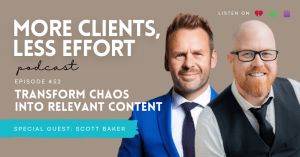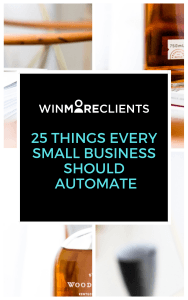So you have purchased a marketing automation platform. Well done!
Before you can sit back and give it the job of engaging with your customers and growing your sales, there is still some work to do. Quite a lot of work, to be honest. However, if you get it right it will take over as your 24 / 7 marketing officer, communicating with your clients while you sleep (or go jet-skiing…or start another amazing side project)
To get the ball rolling your new platform, here are the steps I recommend:
1.Organise and import your contacts
If you’re like many business owners, your contacts are spread out across a couple of different email accounts or stored in a spreadsheet somewhere on your computer. You may also have them sitting within your CRM or in a newsletter system like MailChimp.
Take some time to organise your contacts into csv spreadsheet format. If possible, scrap the stale leads who haven’t opened an email in over two years. You can either delete them or send them a politely worded email asking if they would still like to hear from you.
Tidy your contact information by making clear headings (First Name, Last Name, Email, Phone Number, City etc). Create categories and tag your contacts as ‘Customer’, ‘Supplier’, ‘Yet to buy’, ‘Unsubscribed’ and ‘Gold member’ etc. Your marketing automation system should also allow you to create custom fields and further segment your audience to match your requirements.
If you are using InfusionSoft, you can access the website for instructions on how to import contacts from a range of software including Excel, Microsoft Outlook, SalesForce and Quickbooks. Other providers should have similar instructions as well as a help team to guide you through the process.
2.Get to know your visitors
You may have your avatar and a great idea of your target audience, but how well do you know the people who actually buy from you? This information is important to help you craft your tone and your content.
You have a couple of options for gathering customer data:
- Send a survey asking your customers about what they want. Include questions about their location, their age and their family status (assure responders that their preferences are anonymous)
- Track website traffic to see which pages are most popular
- Track sales and note your best performers overall / seasonally
- Add feedback / review sections to your product pages
- Engage a market research company to do a phone survey
The more you know about your buyers, their lifestyle, their needs and their buying habits, the more you will be able to target your messages and your campaigns to suit them. This kind of information may even change the assumptions you have about your audience.
3. Create a customer journey
Once you know a bit more about your customers, consider the steps they take before hitting ‘Buy Now’.
For example, consider the journey of a mother looking to sign up her child for swimming lessons. Think of the steps should would take but also the positive and negative experiences.
E.g.
– Customer searches for swim schools online
– Customer compares reviews of three different schools
– Customer visits the websites of one school and enters her email address in order to download ‘Five water safety tips every parent should know’
– Customer receives a welcome email from the school, directing her to the pricing and timetable pages on the website
– Customer phones the school and leaves a message
– Nobody calls back, but the customer receives a follow up email directing her to the booking page and offering two free lessons if she signs up within 24 hours
– Customer books ongoing lessons and signs up for regular newsletter
Mapping out a few different customer journeys will help you to form a strategy for your content. It will also help you identify the spots where they may end up giving up and looking elsewhere.
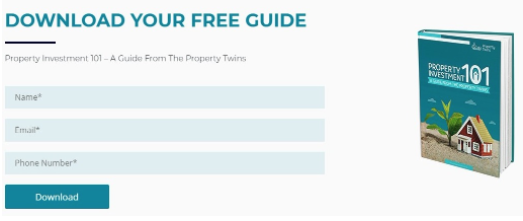
[Sydney’s Property Twins start their customer journey with an eBook, before offering a free consultation to prospective clients and working with them to help them purchase property]
4. Capture new leads
Now you have an automated marketing platform, a contact list and an idea of what your customers want and how they go about getting it, it’s time to build up your contacts.
Turn over a new leaf and make sure you get the details of every customer you interact with. Sign them up at the counter, over the phone and via your website. Once you have their info, check if they are happy to be added to your newsletter database.
Here are a few quick ideas for drawing in new leads:
- Advertise in the local paper with a free offer or discount
- Hold a free webinar or seminar
- Post Facebook ads to drive traffic to your website
- Ask your existing customers to refer a friend and give them an incentive for doing so
- Head to networking events with a short speech prepared about what you do
- Create a partnership with a business that complements yours (e.g. pool cleaner + pool installer)
- Blog on topics that your customers would be likely to ask about and share your blogs on LinkedIn, Facebook and Twitter
- Create stunning product images and share them on Pinterest and Instagram
Keep in mind that there are laws in Australia relating to spam! The rules state you can’t send unsolicited emails and that you must have a clear ‘unsubscribe’ message so your contacts can opt out of hearing from you.
5. Create more leads with gated content (lead magnets)
One of the fastest ways to build your database is with lead magnets on your website. You have seen these before: the pop ups that offer you a cheat sheet, a step by step guide, a discount or simply the promise of awesomeness in return for signing up for a company’s newsletter.
To create a lead magnet that works, think of something of value you can offer your audience. A discount or a voucher is often effective. Some businesses choose to create eBook which gives customers a taste of what they will gain from engaging further.

[Flight Centre keeps their lead magnet simple and uses cheeky text]
The lead magnet you create should be influenced by your customer and the journey you want them to take.
6. Start communicating (email or other)
There’s no point having a marketing automation platform if you don’t use it to email, text or send letters to your customers on a regular basis. Even before you sign up for this kind of software, you should have an idea in mind of how you are going to stay in touch and how you will use it to build sales.
Your strategy could be as simple as sending text message reminders to customers who have an upcoming appointment. It could also include:
- Regular email newsletters
- Monthly deals and specials
- Appointment follow up emails
- Customer surveys and feedback requests
- Thank you emails
- Seasonal greetings / birthday offers
- Good-bye emails for unsubscribers
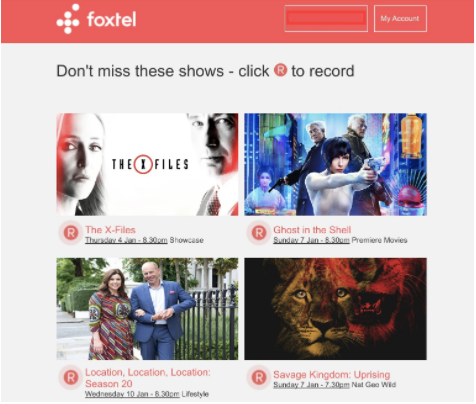
[Foxtel communicates with its customers at the start of each month and makes recording content easier]
To get started, create a flow chart of emails. This will give you an idea of the content you need to write. Your first email will likely be a welcome / hello email to share basic information about your business and see how you can be of assistance.
From there, things can be as simple or as complicated as you like. You can choose to send your content to all users or create categories based on their behaviour and actions they have taken with you in the past.
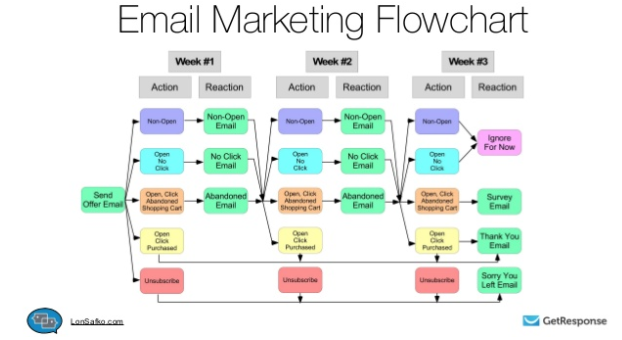
[An example email marketing flowchart from Get Response]
Creating a flowchart can be confusing, so work with a professional if this kind of thing overwhelms you, or if you don’t have the time to set it up yourself. You can also hire a professional copywriter to deliver compelling copy and craft headlines that convert.
Most of your emails will be automatically personalised, set-and-forget content, however you will need to revisit to create time-specific offers and updates.
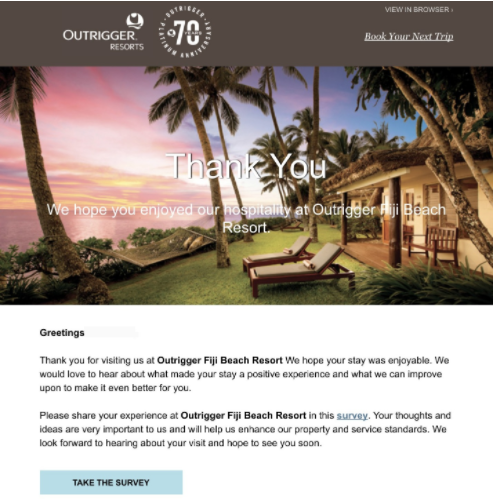
[Outrigger Fiji emails all visitors to thank them for choosing the resort]
7. Understand the data to improve performance
Your final, and perhaps most important step is to keep track.
You may be able to set and forget some of your email communications, but there is always room for improvement. The more you hone in on what your customers respond to, the more effective your automated marketing system will be.
Keep an eye on which of your emails have the highest open rate (number of people opening them) and which have the best click through rate (customers taking action). Do some A/B testing of headlines and see what works best. Scrap the lesser performer and do another test against something else.
Tracking your email performance over an extended period, e.g. 12 months will allow you to identify patterns and determine if your campaigns are paying off for you. Ideally, you will see more sales! If your stats show otherwise, it is time for a new approach.
Your marketing automation system has the power to draw in customers in a way you have never experienced before! For expert guidance and more tips, contact me and let’s create a winning strategy.


